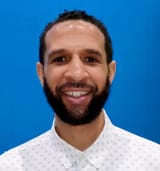Relay for Representation: How one physical therapist's experience encouraged him to bring others along

As a hurdler and jumper (high and long jump) in Track and Field at the University of South Carolina, Curt McGill, DPT thrived under the pressure he put on himself to improve each time he got to the track. Unlike the team sports he played, the only person he was letting down with a bad performance was himself and that’s the one person he’s always been willing to bet on.
The role of the individual performer is one McGill – who prefers to be referred to by his first name, “Curt” – has thrived under, as a physical therapist, as well. Since 2020, Curt has worked in digital health and is now the manager of physical therapy at one of the largest digital health companies.* After completing his doctorate at Duke, in 2012, Curt worked in home health and later in a variety of different roles in a hospital system. It was during the pandemic that the South Carolina native saw the market shifting from traditional in-person outpatient care to expanding virtual access, so Curt made the move to a space he described as “pandemic-proof.”

It’s in his current role, though, that he’s thrived in a team environment. Specifically, Curt has found strength being a team player through his efforts to further diversify the industry and share his experiences with other Black physical therapists. Those efforts have their genesis in an employee resource group (ERG), for Black employees, that he joined four years ago. The group has grown, becoming a source for helping recruit Black professionals and providing company-wide education and mentorship for new Black professionals. Curt has taken on a leadership role within the ERG and also provides mentorship through the National Association of Black Physical Therapists (NABPT) for other Black physical therapists.
Through mentorship, Curt hopes he can be an outlet and resource for young, Black physical therapists. It’s the kind of mentorship Curt didn’t have when he entered a profession where he rarely saw other Black physical therapists.
“First thing I tell young, Black PTs is to get in the mindset that there won’t be a lot of us out there – either male or female,” Curt said. “Second, you’re going to have to hustle and show your worth. Keep displaying your skills each and every single day and preparing your mind to overcome any initial biases through your hard work.”
Second-guessing success
Despite having been a physical therapist for 12 years, Curt says he’s still never worked with another Black, male, physical therapist (even in his current role). It’s why he’s so committed to helping diversify the profession and believes the expansion of digital health will help.
“The patients you serve are going to be diverse and even more so through digital health platforms,” Curt said. “Because of this, our healthcare professionals that are serving these patients also need to be diverse.”
I’m not a healthcare provider, but it was easy to relate to Curt’s experience of being the only Black male and often the only non-white person on his team. You can never be 100% certain what lens your actions are being perceived through and that can be a mental tightrope to navigate by oneself. It’s imperative to have trusted peers to share your experiences with but in many professions, that can be difficult to find. Physical therapy is one of the most difficult. Black physical therapists make up less than 5% of all physical therapists – a shade less than the percentage of Black physicians – while 77% of physical therapists are white (significantly higher than the percentage of white physicians).
“I think a lot of times companies aren’t thinking about getting the best-diverse candidate but are rather trying to find someone fast, to fill the role. If they’re Black ok. If not, ok. To achieve more diversity it has to be an overall objective in your hiring process. It can work but you need to get more diverse folks in the pipeline, going through the process.”
Why representation matters?
In healthcare – where there is a long history of racial negligence, leading to medical mistrust – the lack of representation can have dire implications. There’s a growing catalog of data that show improved health outcomes among non-white patients who are matched with a non-white healthcare provider.
But what happens when the roles are reversed and a minority healthcare provider is treating patients from the dominant demographic?
"I’m not here to change your biases. I'm here to help you overcome your injury."
Early in his career, Curt experienced this, while working in rural, predominantly white areas. He notes that 98% of his patient interactions were positive but there were some situations where patients requested another therapist. At times it’s been clear it’s about his skin color, like the patient who used a racial epithet when telling him why he wanted a different therapist. Other times it’s not as obvious. Those times are the most challenging as one can never objectively know if the request was due to bias or if there was something you could have done better.
“At the end of the day, if I’m doing the best I can within my scope of practice and someone requests another provider, that’s just something I accept ,” he said. “The way I frame it is, if this individual doesn’t want my help, there’s plenty of other people that would love my help. I’m not here to change your biases. I'm here to help you overcome your injury.”
The biases haven’t only stemmed from patients. Curt recalls a clinical instructor he had in grad school, after starting his clinical rotations. The instructor had two concurrent physical therapy students; Curt, and a white student. Curt noted his actions were consistently questioned and mistakes magnified in ways the other student’s weren’t.
“You’ve got two students coming to the same rotation to learn – we should both be treated the same,” he said.
Both situations are ones he knows other Black PT students will likely face but hopes his experiences will provide some perspective.
“I just want to be able to talk them through my experiences so they don’t feel like, 'maybe it’s me,' and not the system,” Curt said.
Curt is seeing positive evolution at the grad school level, with Diversity Equity and Inclusion (DEI) programs designed to support and retain students of color in PT school; programs that were not there when he attended 12 years ago.
“From an educational standpoint, it seems like schools are trending in the right direction,” he said. “I definitely think they (Black PT students) are still experiencing some of the things I experienced but probably to a lesser degree than I did.”
Trish Crane, PT of MossRehab in New Jersey discusses the need to diversify physical therapy, a profession that's nearly 80% white.
Blueprint to improve diversity
When it comes to diversifying at the corporate level, Curt sees two glaring factors preventing organizations from diversifying:
- A commitment from senior leadership
“Whatever values the senior leadership team has, at a company, are going to drive action all the way down to the lower levels. I’ve been fortunate to work for some companies that do value (diversity) and it’s obvious by the employees that work there.”
- A lack of strategic planning by HR
“I think a lot of times companies aren’t thinking about getting the best-diverse candidate but are rather trying to find someone fast, to fill the role. If they’re Black ok. If not, ok. To achieve more diversity it has to be an overall objective in your hiring process. It can work but you need to get more diverse folks in the pipeline, going through the process.”
Curt recognizes HR departments are often stretched thin and faced with the task of filling the seat of an unexpected departure, which is why he pleads not to do it alone but rather, plan ahead by creating strategic partnerships with organizations committed to diversifying healthcare.
He notes the NABPT, American Academy of Physical Therapy (AAPT), Black Health Connect and Historically Black Colleges and Universities (HBCUs) as great resources.
“These organizations are out here waiting for companies to partner with them to help drive diversity,” he said.
Curt's clinical call to action
Likewise, Curt is ready to help with the transition. He still promotes the track and field mentality but in doing so, he hopes to inspire generations of Black PTs to hand the baton off to one another.
“You’re going to have to hustle and show your worth every day because you don’t know what type of biases people might be operating with,” he advises Black PTs just getting out of grad school. “You need to display your skills in each and every single scenario. From a diversity standpoint, I think that’s the most important thing for new PTs to prepare their minds for when deciding to enter this career.”
*Note: To avoid the yellow tape of getting this story approved by his employer, Curt and I opted to leave the name of his employer out.
Stephen Norris is a digital health leader and health equity advocate with over 10 years of experience building successful provider partnerships. Based in Seattle, WA, he's currently seeking new opportunities to leverage his expertise in a progressive, digital health setting.
His most recent role saw him leading strategic provider partnerships for a mission-driven, digital health startup in the workers' comp space. There, he built a robust provider network, leading provider adoption of the company's SaaS documentation platform. In doing so, he helped secure several Fortune 500 payers and spearheaded initiatives that expanded and retained key regional and national provider groups. Notably, he piloted the company's DEIJ initiatives, resulting in improved employee morale and record engagement.
Norris brings a well-rounded background in journalism and experiential marketing, which, when coupled with his provider partnership expertise and dedication to health equity, allows him to develop unique strategies for building and growing successful partnerships.
To contact Norris, you can email him at snorris32@gmail.com or reach out via Linkedin.




